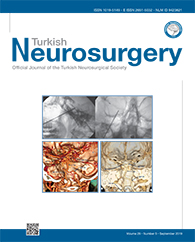Turkish Neurosurgery
2019 , Vol 29 , Num 5
A Trial for an Evaluation of Perianeurysmal Arterial Pressure Change during Carotid Artery Stenting in Patients with Concomitant Severe Extracranial Carotid Artery Stenosis and Ipsilateral Intracranial Aneurysm
1Nara Medical University, Department of Neurosurgery, Kashihara, Nara, Japan2Nara Medical University, Department of Radiology, Kashihara, Nara, Japan DOI : 10.5137/1019-5149.JTN.20418-17.0 Concomitant occurrence of severe extracranial large vessel stenosis and an ipsilateral intracranial aneurysm is often detected incidentally, but the optimal therapeutic strategy is not clear. Several reports have investigated whether simultaneous carotid artery stenting (CAS) and coil embolization, or multi-stage therapy is better. These treatment strategies are still controversial because simultaneous therapy will decrease the risk of aneurysm rupture, but may also increase the risk of thromboembolic complications. For multi-stage therapy, the interval between CAS and coil embolization for the ipsilateral intracranial aneurysm remains obscure. We experienced a case of severe extracranial internal carotid artery stenosis, ipsilateral intracranial aneurysm. Multi-stage therapy was chosen, and perianeurysmal arterial pressure did not increase over 100 mmHg after CAS. Subsequent ipsilateral coil embolization was performed 3 weeks later with careful blood pressure control to prevent aneurysmal rupture and with the expectation of stable neointimal formation over the stent strut to prevent thrombotic complications during coil embolization. All procedures were performed without any complications. We suggest that evaluation of perianeurysmal arterial pressure may be helpful for selecting a treatment strategy in patients with multiple ipsilateral lesions to prevent thromboembolic and hemorrhagic complications. Keywords : Ipsilateral unruptured aneurysm, Perianeurysmal arterial pressure, Severe extracranial carotid artery stenosis





